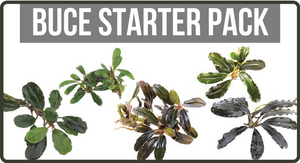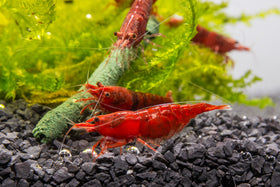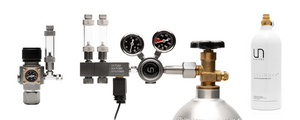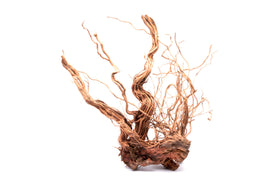
How to Care for Guppies: Care, Diet, and Breeding
Whether you're new to aquariums or a seasoned pro, it's important to know the basics of caring for guppies. This article will cover the basic care needs of fancy guppies, including water conditions, food, and tank mates. We will also discuss how to breed guppies and care for their offspring.
This article will go over:- All About Guppy Fish
- How Do I Care For Guppies?
- What Can I Feed My Guppies?
- Popular Guppy Tankmates
- How To Breed & Raise Guppies
- Ensuring Success With Guppies
All About Guppy Fish
The fancy guppy (Poecilia reticulata) common in the pet trade today originated in South America where they were first identified in the 1860s. Guppies are a small freshwater fish that grow about 2 inches long, with females being slightly larger. Guppies are livebearers and give birth to live young.
Originally, people used them for mosquito control, but they eventually became popular in the aquarium hobby. Through selective breeding, guppies now come in a stunning array of colors, patterns, and fin types. Today, these colorful fish are easy to find at your local fish store or online retailers. Prices can range from $2 to $3 to several hundred dollars for specialty breeds.
Guppies are popular because of their bright colors and patterns, making them a great choice for hobbyists. They stand out in a densely planted aquarium with their lively swimming behavior.
They are hardy and adaptable to a range of water parameters, making them perfect for beginners. They are low-maintenance, breed easily, and their lively nature adds a dynamic element to any aquarium. Plus, their peaceful temperament makes them compatible with a wide variety of other species in a community tank setup.
How Do I Care For Guppies?
Tank Setup and Environment: Guppies are beginner-friendly fish with easier care requirements. However, they still require optimal water parameters and maintenance for health and longevity. Follow these guidelines to set yourself up for success in caring for this species:
- Tank Size: A 10-gallon tank is the bare minimum for a group of six guppies (two males, four females). A 20 to 50-gallon tank is even better as guppies are energetic swimmers that will inhabit the middle and top portions of the tank. They also breed a lot, so it's better to have a bigger tank to support their population long-term. Guppy fish like their water slightly alkaline with a pH between 7.0 and 8.0 to stay healthy and colorful.
- Water Temperature: Keep the water between 76-78°F (24-25°C) for a lifespan of 2-3 years. Guppies are tropical fish that require an aquarium heater. Fancy varieties are less resilient to cooler temperatures compared to their wild counterparts. Raising the temperature to 82°F (27°C) accelerates growth and breeding but reduces their lifespan to about 18 months.
- pH Levels: Guppies prefer a pH between 7.0 and 8.0. Slightly alkaline water is best for their health and colors. If your tap water isn't in the ideal range, consider adding crushed coral to your aquarium to increase pH.
- Water Hardness: Guppies prefer harder water with sufficient amounts of calcium, magnesium, and other essential minerals. A hardness level (dGH) between 8-12 is optimal. If your tap water isn't already hard, consider adding minerals to the water so it stays hard.
Lastly, an effective filtration system is crucial for keeping aquarium water clean and well-oxygenated. Weekly water changes and regular filter maintenance help maintain water quality and keep your guppies healthy. You can improve your freshwater tank by adding live aquatic plants. They not only make your aquarium look better, but also help with biological filtration.
How To Set Up A Guppy Tank
To ensure a harmonious tank, stock 2-3 females for every male. If you notice males aggressively chasing females, add more live plants to the tank to give females areas of refuge. While it may be tempting to overstock males because of their bright colors, ensure your tank has the correct gender ratio for success.
Ensuring the tank setup is safe for guppies is important. Sharp or rough hardscape can easily tear their delicate fins, leading to injury and infections. To keep your guppies safe, pick decorations with smooth edges and use live plants such as Anubias, Java Fern, and Java Moss. Be sure to file down the sharp edges of any new decor introduced to the tank.
Guppies with longer fins also need increased water flow as it helps them stay active and build stronger muscles. Water movement simulates a natural environment and encourages exercise which promotes good health. Additionally, good water flow ensures optimal circulation throughout the aquarium, removing dead spots and keeping water quality high.
How To Identify Healthy vs. Sick Guppy Fish
Healthy guppies display vibrant colors, are active swimmers, and feed eagerly. In contrast, sick guppies often show signs of illness that are easy to spot if you know what to look for.
Sick fish may exhibit signs such as clamped fins, fatigue, loss of appetite, fading color, and abnormal swimming behavior. This can include erratic movements or gasping for air near the surface. These signs are indicators of potential health issues in fish.
Monitoring fish closely for any unusual behavior or physical changes is important.These signs indicate stress or the onset of disease. White spots, red patches, or visible parasites on the body are also clear indicators of illness. Keep a close eye on your guppies for these symptoms. By acting early, you can treat and stop the spread of disease in your aquarium.
What Can I Feed My Guppies?
Feeding your guppies a varied diet ensures they receive the nutrients necessary to support vibrant color and optimal health. Fortunately, feeding is one of the easiest aspects of caring for this species as they are omnivorous. Guppies will accept a wide range of foods like flakes, pellets, frozen and live foods, and even algae.
Here’s a breakdown of a guppy's diet needs:
- Commercial Blend: High-quality fish food form the staple of their diet, as they are a balanced food source offering a mix of nutrients. Flakes and micro-pellets may suit guppies' small mouths and help maintain water quality.
- Frozen/Live Foods: Supplement with foods like brine shrimp, daphnia, and mosquito larvae.
- Vegetables: Occasionally feed blanched vegetables like spinach or peas to help with digestion. Guppies can develop nutritional deficiencies if they are only fed high-protein meals.
As a rule of thumb, feed adult guppies one to two times daily. With fry, increase the number of feedings to three to five times a day, but reduce meal size to maintain water quality.

Popular Guppy Tankmates
Guppies are peaceful fish that can live with many types of tropical fish, making them a good choice for community tanks. To add variety to your aquarium, consider these ideal tank mates for your guppies and live plants.
Tetras: Neon tetras and other small, non-aggressive tetras make great companions for guppies. They share similar water requirements and are equally peaceful small fish. Additionally, they have varied colors and patterns add extra visual interest to your planted tank.
Corydoras: These bottom-dwelling catfish are excellent additions to a community tank. Corydoras keep to themselves and keep the substrate clean.
Mollies and Platies: Mollies and platies are similar to guppies in temperament and care needs. They enjoy the same water conditions, are livebearers, and can peacefully share a tank.
Nerite Snails: Nerite snails are excellent tankmates because of their peaceful nature. They are unable to reproduce in freshwater. They can eat algae and uneaten food, keeping water quality clean and parameters stable. They also have unique shell patterns that add visual interest to your aquarium.
Freshwater Shrimp: Freshwater shrimp make great tank mates because of their non-aggressive nature. They pick at algae and uneaten food, keeping the tank clean. They also come in bright, eye-catching colors that complement guppies and other inhabitants.
Avoid housing guppies with large or aggressive fish. Fish that are bigger or have a tendency to bully can harm or stress your guppies—like barbs and aggressive tetras.
Can Guppies Live With Bettas?
Anecdotal evidence suggests that solo male bettas may be compatible with guppies. It comes down to the betta's personality, as some are more territorial than others. We advise against housing guppies with slow-moving fish because guppies will outcompete these species for food. Ultimately, choosing compatible tank mates ensures a harmonious and healthy environment for your guppies and their tank mates.
How To Breed & Raise Guppies
Fancy guppies, often called the "million fish," are famous for their prolific reproduction habits. Keep reading to learn about all aspects of guppy breeding and how to successfully raise their fry:
How To Sex Guppy Fish
Sexing guppies is straightforward. Male guppy fish are smaller with brighter colors and a modified anal fin called a gonopodium. Females are bigger in size, less colorful, and have a fan-shaped anal fin.
To increase breeding opportunities, stock 2-3 females for every male. This ratio reduces stress on females.
How To Breed Guppy Fish
Guppies are prolific breeders, and if there are males and females present in your tank, chances are they've already bred. Guppies can start breeding at just two months old and easily breed in a home aquarium. If both sexes are in the same tank, it is likely that fertilization has already occurred.
Guppies are livebearers, meaning they give birth to live young rather than laying eggs. To increase the number of fry produced, feed breeding adults live foods. Additionally, perform regular partial water changes to keep the water quality high in the breeding tank.
How To Tell If A Guppy is Pregnant
Guppies do not lay eggs, instead giving birth to live young. Female guppies can give birth every 30 days, with pregnancies lasting 28-30 days under ideal conditions. Each batch can yield 20 to 50 fry.
You can look for several signs to determine if a guppy is close to giving birth. As the pregnancy progresses, you may notice her abdomen becoming more rounded and taking on a boxy shape. This change in shape is one of the clearest indicators she is approaching her due date.
Another key sign is the presence of a gravid spot—a dark area located near the female's anal fin. The gravid spot becomes more pronounced as the fry develop. Additionally, pregnant guppies often exhibit changes in behavior. They may become more shy and reclusive, seeking out hiding spots within the tank to prepare for birth.
You might also observe pregnant females swimming less and appearing more lethargic as she nears her due date. By noticing changes in behavior and physical signs, you can predict when your guppy will give birth. This will help you prepare and keep both the female and fry safe and healthy.
How To Raise Guppy Fry
Raising guppy fry can be a rewarding experience as you watch them grow from tiny newborns to colorful adults. Here’s a step-by-step guide on how to care for them at each stage of their development:
1. Initial Care
Adult guppies will eat their own young unless you offer ample hiding places for the young fish. Breeding boxes or live aquarium plants like Hornwort, Java Moss, and Water Lettuce make excellent refuge for vulnerable fry. Floating plants also protect fry from hungry adults. To prevent fry from getting sucked up, use a pre-filter sponge or guard to block the filter intake.
To maximize the number of fry that reach adulthood, transfer the gravid female to a separate tank just before she gives birth. After the birthing process, it's crucial to separate the mother from her fry, as she will likely eat her own young.
2. Feeding Newborn Fry
For the first few days, fry rely on their yolk sacs for nutrition. Once they fully absorb the yolk sac, they will start swimming and actively searching for food. At this point, begin feeding them infusoria, which are tiny organisms perfect for newly hatched fry. You can also make cultures at home or buy them at pet stores.
3. Transition To Fry Food
As the fry grow within the first week, start introducing Powdered Fry Food. Specifically formulated for young fish, it provides essential nutrients while being easily digestible. Feed small amounts every two hours, or five to six times a day, to accommodate their small stomachs and mouths.
4. Introducing Baby Brine Shrimp
Around 1-2 weeks old, guppy fry can start eating live Baby Brine Shrimp. Rich in protein and essential fats, baby brine shrimp stimulate growth and enhance coloration. Feed twice a day alongside powdered food until they are larger and more robust.
5. Gradual Transition to Crushed Flake Food
By the time guppy fry are 2-3 weeks old, they can begin to consume Crushed Flake Food. Start by crushing high-quality flake food into tiny pieces that they can easily ingest. Gradually increase the size of the food as they grow and their mouths develop.
6. Ready for Adult Food
Guppy fry are large enough to eat the same food as adult guppies at 2-3 months old. Transition them slowly to standard flake or pellet food suitable for tropical fish.
- During the early stages of growth, feed baby guppies small meals several times a day to help them grow quickly. Monitor their development closely and adjust feeding amounts as needed to prevent overfeeding or underfeeding.
When the young fish start showing their colors (around two to three months old), you can breed more, give some to friends, or sell them to a fish store.
Ensuring Success With Guppies
Guppies are a delightful addition to any freshwater aquarium, offering beauty, ease of care, and breeding excitement.
A well-maintained aquarium keeps your guppies happy and creates a stunning display of color in the comfort of your own home. Follow this guide to learn how to care for your guppies and keep them healthy and happy. By following these tips, you can ensure that your guppies thrive for a long time.
Click here to check out our entire Guppy Fish collection!
Tell us - Was this article helpful? Please comment your thoughts below!
If you have any questions regarding this article, please DM us on Instagram or Facebook (@buceplant), or email us directly at support@buceplant.com so we can assist you - questions will not be answered here.














Leave a comment